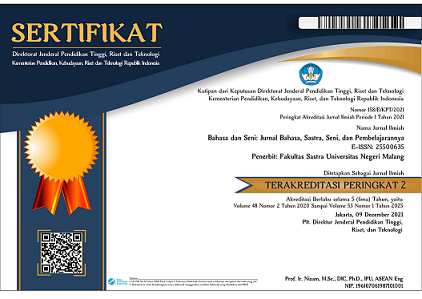Persepsi mahasiswa terhadap informasi hoax di media digital
Abstract
Student perception of hoax information in digital media
This study aims to determine student perception of hoax information distributed in digital media. The research is a survey study involving bachelor and master’s students from 18 study programs at the Faculty of Letters, Universitas Negeri Malang, as participants. Data were collected through questionnaires circulatedonline using Google Form. They were then analyzed using SPSS, including Descriptive Statistics and Independence Sample T-Test. The results showed that the majority of students aredeeply concerned about hoax information in digital media. The majority of students checked the information available in the media, confirmed whether the information received is valid, and further assessed that media such as radio, newspapers, television, magazines, and social media can spread hoaxes.
Keywords: survey, perception, hoax, digital media
Persepsi mahasiswa terhadap informasi hoax di media digital
Tujuan penelitian ini yaitu untuk mengetahui persepsi mahasiswa terhadap informasi hoax yang tersebar di media digital. Desain penelitian yang digunakan adalah penelitian survei dengan responden penelitian yang terdiri dari mahasiswa program D3, S1 dan S2 pada 18 program studi di Fakultas Sastra Universitas Negeri Malang. Pengumpulan data angket dilakukan secara daring menggunakan aplikasi Google Form. Data kemudian dianalisis menggunakan SPSS, meliputi Descriptive Statistics dan Independence Sample T-Test. Hasil penelitian menunjukkan bahwa mayoritas mahasiswa mempunyai kepedulian yang tinggi terhadap informasi hoax di media digital. Mayoritas mahasiswa memeriksa informasi yang ada di media, serta memastikan informasi yang diterima valid. Kemudian menilai bahwa media seperti radio, surat kabar, televisi, majalah dan media sosial dapat menjadi sarana untuk menyebarkan hoax.
Kata kunci: survei, persepsi, hoax, media digital
Full Text:
PDFReferences
Aditiawarman, M. (2019). Hoax dan hate speech di dunia maya. Lembaga Kajian Aset Budaya Indonesia Tonggak Tuo.
Aldwairi, M., & Alwahedi, A. (2018). Detecting fake news in social media networks. Procedia Computer Science, 141, 215–222.
Bondielli, A., & Marcelloni, F. (2019). A survey on fake news and rumour detection techniques. Information Sciences, 487, 38–55.
Dinas Komunikasi dan Informatika. (2020, October 9). Rekap total laporan isu hoaks Covid-19. diskominfo.co.id
Field, A. (2013). Discovering statistics using IBM SPSS statistics (4th Edition). SAGE Publications Inc.
Finnerman, T., & Thomson, R. (2018). A family falsehold: Deception, media hoaxes and fake news. 39(3), 350–361.
Husain, S. A. E., & Kilagwa, R. T. (2019). The effect of message credibility on media use and perseption of fake news among students. A Journal of the Pasific and Asian Communication Association, 1(2), 1–21.
Juditha, C. (2018). Interaksi komunikasi hoax di media sosial serta antisipasinya. Jurnal Pekommas, 3(1), 31–44.
Kementrian Hukum dan Hak Asasi Manusia. (2000). Perubahan kedua UUD negara RI tahun 1945.
Kovacs, K. (2020, June 4). Gen Z has a misinformation problem. Digital Content Next. https://digitalcontentnext.org/blog/2020/06/04/gen-z-has-a-misinformation-problem/
Kunnath, J. P., & Jackson, A. (2019). Developing student critical consciousness: Twitter as a tool to apply critical literacy in the english classroom. Journal of Media Literacy Education, 11(1), 52–74.
Lee, K., & Talwar, V. (2014). Children and lying: A century of scientific research. Blackwell.
Manalu, R., Pradekso, T., & Setyabudi, D. (2018). Understanding the tendency of media users. Jurnal Ilmu Komunikasi, 15(1), 1–16.
Mutmainnah. (2018). Respon mahasiswa komunikasi dan penyiaran Islam UIN Alauddin Makassar terhadap hoax di media sosial [Skripsi]. Universitas Islam Negeri Alauddin Makassar.
Nurkinan. (2017). Dampak media online terhadap perkembangan media konvensional. Jurnal Politicom Indonesia, 2(2), 28–42.
Nygren, T., & Guath, M. (2019). Swedish teenagers’ difficulties and abilities to determine digital news credibility. Nordicom Review, 40(1), 23–42.
Oblinger, D., & Oblinger, J. L. (Eds.). (2005a). Educating the net generation. EDUCAUSE. http://bibpurl.oclc.org/web/9463
Oblinger, D., & Oblinger, J. L. (Eds.). (2005b). Educating the net generation. EDUCAUSE. http://bibpurl.oclc.org/web/9463
Prameswari, N., & Ganinda, N. (2019, Oktober). Pakar: Indonesia bisa jadi panutan dalam mengatasi tantangan di era hoax. VOA Indonesia.
Pratama, H. S. (2019). Buku panduan berpikir kritis menghadapi berita palsu (hoaks) di media sosial. International NGO Forum on Indonesian Development (INFID).
Rayess, M. E., Chebl, C., & Joseph Mhanna. (2018). Fake news judgement the case of undergraduate students at Notre Dame University-Louaize, Lebanon. Creative Commons Attribution, 46(1), 146–158.
Rosenbaum, J., & Bonnet, J. (2020). Looking inward in an era of ‘fake news’: Addressing cognitive bias. Young Leader of the Americans Initiative. https://ylai.state.gov/
Sterrett, D., Malato, D., Benz, J., Kantor, L., Tompson, T., Rosenstiel, T., Sonderman, J., & Loker, K. (2019). Who shared it?: Deciding what news to trust on social media. Digital Journalism, 7(6), 783–801. https://doi.org/10.1080/21670811.2019.1623702
Steward, K. (2019). Do you trust me(dia)? How students perceive and identify fake news [Thesis, Honors College]. https://digitalcommons.pace.edu/honorscollege_theses/203
Sugihartati, R. (2014). Perkembangan masyarakat informasi & teori sosial kontemporer. Kencana. https://books.google.co.id/books?id=AJFBDwAAQBAJ
Supratman, L. P. (2018). Penggunaan media sosial oleh digital native. Jurnal Ilmu Komunikasi, 15(1), 47–60.
Swayne, M. (2019). Reseachers identify seven types of fake news, aiding better detection [Phys.org].
Thellefsen, T., & Sørensen, B. (Eds.). (2017). Umberto Eco in his own words. De Gruyter Inc.
Tim BIP. (2007). Undang-undang informasi dan transaksi elektronik. Bhuana Ilmu Popular.
Tim GDI. (2020). Global digital insight. datareportal.com
DOI: http://dx.doi.org/10.17977/um015v49i12021p67
Refbacks
- There are currently no refbacks.

This work is licensed under a Creative Commons Attribution 4.0 International License.

Dear Sir/Madam
We appreciate your continued confidence and trust in Bahasa dan Seni: Jurnal Bahasa, Sastra, Seni, dan Pengajarannya (JBS). In order to enhance the service, readability, and quality of JBS publications, we will be transitioning to a new website, https://citeus.um.ac.id/jbs, in collaboration with Digital Commons (Elsevier) starting in July 2024.
Sincerely
Yusuf Hanafi
(Editor in chief)















2.png)